Euphorbia edged: planting and care in the open field

Landscaping is one of the popular areas for the improvement of a personal plot, a park and a green recreation area. For landscaping the selected area, designers use a huge number of plants, the range of which is constantly increasing due to the painstaking work of breeders and biologists.
Professional masters in the field of landscape design recommend paying attention not only for popular ornamental plant species, but also use flowers given to us by nature in our projects. One of the unique plants with a bright and beautiful appearance is the edged euphorbia. It can be a decoration for any flower arrangement.

Peculiarities
Euphorbia edged is a poisonous plant, the milky sap of which contains euphorbin. Biologists call this plant "euphorbia marginata", "mountain snow" and "snow in the mountains". The plant belongs to the Euphorbia family and belongs to annuals. The natural habitat of this flower is the mountain slopes of the United States. The appearance of the flower resembles a snow-white ball. A distinctive feature is the presence of a white border on the leaves.
The annual plant has straight stems up to 85 cm high with pale green leaves. The shape of the leaves can be either round or pointed. The inflorescences are small and white. The flowering period lasts from mid-summer to early winter.
At home, the plant can live for several years, so it automatically becomes a perennial.

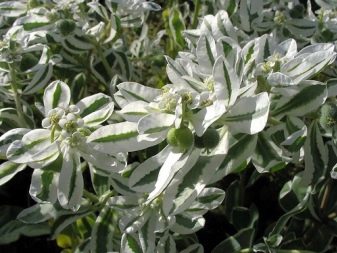
Landing
For planting plants in open ground, gardeners recommend using seedlings grown at home. In mid-May, strong and healthy seedlings from containers can be transplanted into sunny areas of the garden. The optimal distance between the planting pits is 35 cm. Experts do not recommend planting the plant in wet and swampy areas. Basic rules and features of planting seedlings in open ground:
- complete cleaning of the site from debris and weeds;
- the formation of planting holes at a distance of more than 30 cm from the edge of the flower bed;
- joint planting of plants only with the same root system;
- to protect the flower arrangement from dust and dirt, it is advisable to plant snow balls from the side of the road;
- sunlight is the key to abundant and beautiful flowering;
- moistening the soil only by watering at the root;
- the most favorable area for growth is the southern and eastern parts of the personal plot;
- before the onset of frost, it is necessary to cut off the upper shoots and remove the entire root system;
- feeding is permissible only in the evening;
- to obtain young plants from seeds, it is necessary to weed the flowerbed in the spring and moisten the soil.



It is strictly forbidden to plant a plant near children's recreation areas and near walking pets.
To grow a flower at home, you need to choose low containers with a large diameter.


How to care?
Euphorbia fringed is an unpretentious plant, the cultivation of which will not cause difficulties even for novice florists. The flower can be planted both in open ground and in flower pots. Water the flower sparingly and regularly. The plant easily tolerates drought and has a negative attitude towards waterlogged soils. In the summer, it is enough to moisten the soil Once a week... When growing a flower at home, watering is carried out only after the soil has completely dried. Experts do not recommend spraying the spurge.
To plant a flower, you must choose sunny and warm place. Indoors, the optimum temperature for growth should be in the range from +22 to + 24 degrees. An unpretentious plant can grow in an area with a high content of sand and gravel, but prefers nutritious soil mixtures. Botanists recommend using loose, nutritious and fertile soil with low acidity for planting.
At the bottom of the flower pot, it is imperative to pour a mixture of agroperlite, sand and sod soil.
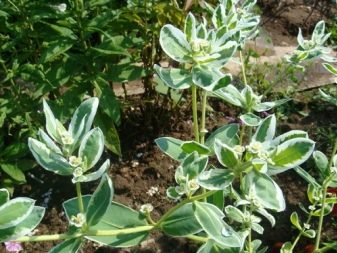

To stimulate the growth of young shoots it is necessary to regularly carry out sanitary pruning of dried trunks and foliage, as well as remove rotten roots. Pinching the crown allows the plant to release side shoots and acquire a lush crown. Before performing this type of work, it is imperative to wear garden rubber gloves, and after trimming, rinse the tools with running water and treat with disinfectants.
The plant responds positively to the introduction of potash, phosphorus and organic fertilizers. During flowering, experienced gardeners recommend feeding the flower with rotted manure or compost. Fertilizers can be applied 3-4 times a year at the same time intervals. Novice growers should take into account that an excess of nutrients can provoke massive growth of shoots and lead to a decrease in the number of inflorescences.
In comfortable conditions, the snow globe will delight with abundant flowering until the end of autumn.

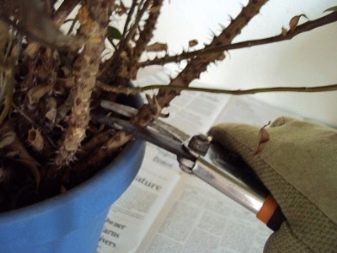
Reproduction
Reproduction of the plant is carried out by seed and cuttings. Seeds for planting can be purchased at specialized stores or collected by yourself. After flowering, a small box with three seeds is formed on the plant. After the seed box is fully ripe, it is necessary to pluck it and remove the seed material.
In the period from February to April, seeds can be planted in prepared containers with nutrient soil. The height of the planting container should not exceed 120 mm. Before sowing seed in the ground soak it for 2-3 hours in warm water.
The prepared seeds are spread over the soil surface and moistened with a spray bottle. The surface of the pot should be sprinkled with a mixture of peat and sand and covered with plastic wrap. The most comfortable temperature for germination is + 18 degrees.


To prevent the surface of the container from getting too hot it is necessary to remove the film for airing daily. Potted soil should not dry out. Only after the appearance of the first shoots can the film be removed, and at the stage of formation of two leaves, a pick can be carried out.
To obtain a new plant from a cutting, it is necessary to cut a cutting about 15 cm high from a healthy and strong shoot in the middle of summer and place it in water, where the growth enhancer of the root system has been added. You can use a damp peat mixture to germinate the roots. To prevent infection of the plant with fungal diseases, the resulting cut must be treated with charcoal powder. Only plants can be planted in open ground with a strong and developed root system.
Florists who grow euphorbia in flower pots recommend paying attention to another breeding method - dividing the bush. This method can only be used during the resting phase, which begins in early winter and continues until early spring. To obtain planting material, it is necessary to remove the plant from the pot and divide its root system into several parts.
Before planting the resulting shoots, dry and rotten roots must be cut off.


Diseases and pests
The plant is not only unpretentious, but also resistant to various diseases.Novice gardeners need to take into account the fact that improper care can provoke the development of fungal diseases, which are treated with special chemicals. In the case of improper watering, low light levels, the presence of drafts and a lack of nutrients, the plant begins to turn yellow and fall off the leaves, and the root system also decays. The following types of insects can harm the plant and provoke its death:
- spider mite - the appearance of a light bloom on the inside of the leaf and white hairs on the surface of the entire plant;
- mealybug - the appearance of white bloom on the leaves;
- scabbard - the presence of brown and white spots on the leaf plate;
- thrips - the appearance of white spots on the leaves and the surface of the soil;
- aphid - the presence of small larvae on all parts of the plant;
- whitefly - the appearance of yellow and white spots on the sheet and its subsequent twisting;
- root bug - wilting of a flower.
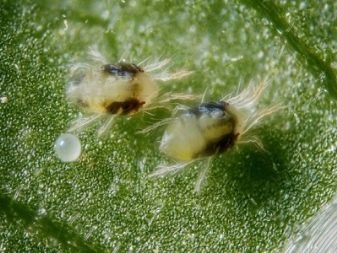
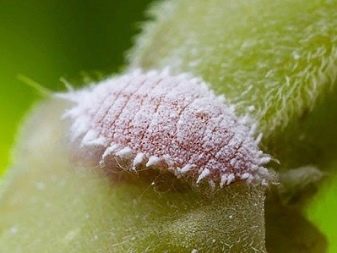
A list of the most common diseases and their causes:
- gray rot - a high level of air humidity, the presence of a large amount of nitrogen in the soil, a low level of ventilation;
- alternaria - high ambient temperature and high air humidity;
- root rot - waterlogging of the soil, high air temperature, low level of illumination, uncontrolled application of nitrogenous fertilizers and poor soil quality;
- powdery mildew - high air temperature, low humidity and dry soil;
- tobacco mosaic - damage to the plant by whitefly.


Examples in landscape design
Euphorbia is a popular plant in the decoration of parks, alleys and flower beds. Its unpretentiousness and undemandingness to watering and soil quality make it possible to plant plants in the most remote corners of the personal plot. The white ball can be used not only as an independent plant, but also as a decorative background in flower arrangements.
- Designers plant mountain snow together with phloxes, monards, all types of cereals and buzulniks.


- A high level of decorativeness and a stable height make it possible to combine a flower with different types of shrubs.


- Designers often use a white cloud to revive a gray and nondescript building area.

- Experts recommend planting the plant in small groups around conifers, as well as making bright compositions of juniper and milkweed.


- Florists add twigs of mountain snow to bouquets of roses, mallows, dahlias and delphiniums.


- Experienced gardeners recommend planting white balls around the edges of the plot. The poisonous plant will scare away rodents and harmful insects.
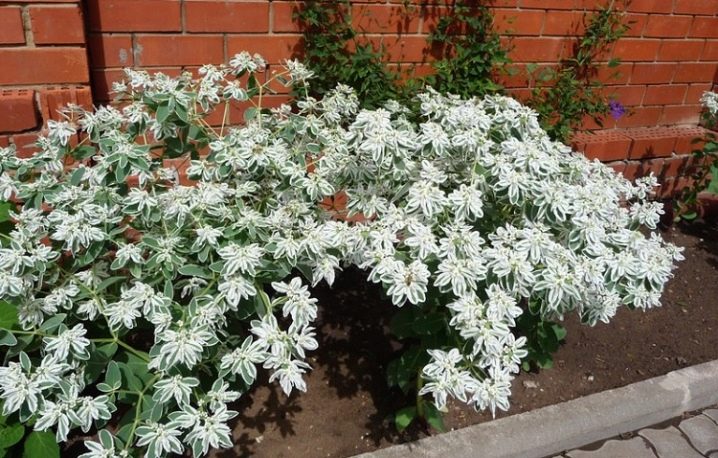
The high speed of urban life and the dullness of concrete structures are increasingly leading to the moral exhaustion of residents of large cities. Psychologists strongly recommend spending weekends outside the city, in parks or green recreation areas. Clean air and bright flower arrangements will give an opportunity to restore vitality and get rid of fatigue. In order to decorate a personal plot on your own, it is not necessary to purchase expensive plants.
Simple and unpretentious flowers will help you create unique compositions and spend a minimum amount of money.

You can find tips for caring for edged milkweed by watching the video below.























































The comment was sent successfully.